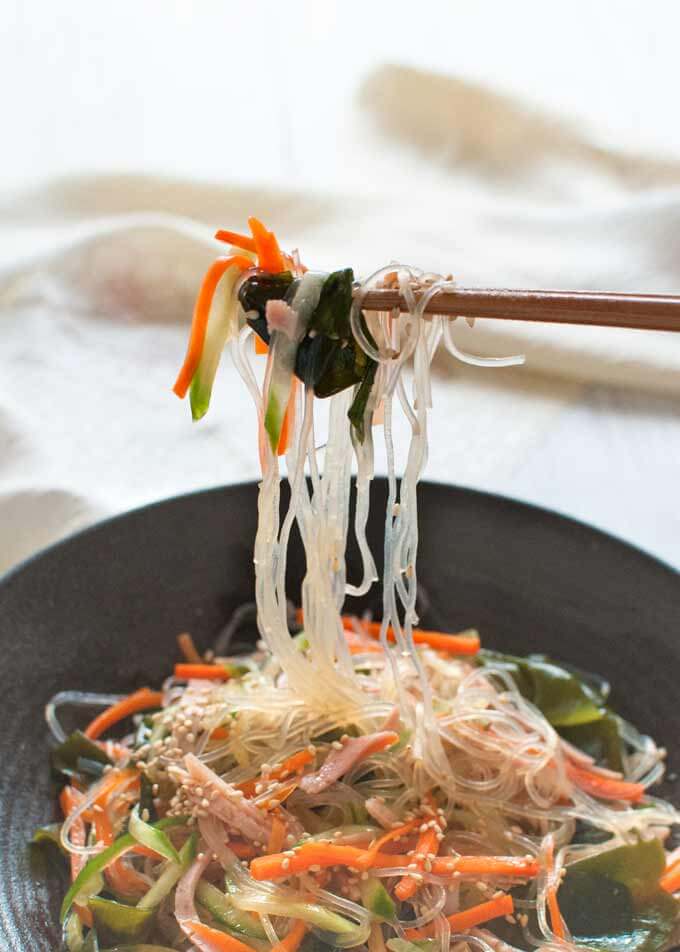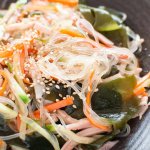Japanese Vermicelli Salad (Harusame Salad) is a refreshing summery salad with julienned ham, cucumber, carrot and wakame seaweed. It is simple and fast to make. It can also be a main dish just like noodle dishes!

Vermicelli Salad is one of the salads that are always sold at ‘depachika’ (デパ地下) – the food markets on the underground level of Japanese department stores. ‘Depa’ (デパ) came from ‘department store’ and ‘chika’ (地下) means underground.
Vermicelli Salad is particularly popular in hot summer, perhaps because the translucent noodles bring coolness and a refreshing feeling to diners.
Vermicelli can be many different things depending on cuisines. For Italians, vermicelli is a very thin pasta. In Asia, thin rice noodles are called rice vermicelli. Dried thin noodles made from either mung bean or potato starch are also called vermicelli (or vermicelli noodles) and this is what I am talking about today.
Harusame (Japanese Dried Vermicelli)
In Japan, dried vermicelli is called ‘harusame’ (春雨), which literally means spring rain. The name came from the appearance of very thin dried vermicelli noodles as they look like gentle rain in spring. It’s so poetic, isn’t it?

Harusame is made from either mung bean starch, potato starch or combination of those starches. The harusame that I used in today’s recipe contained a mixture of mung bean and potato starches.
I bought a pack of harusame from the Japanese grocery store (see the left photo above) but instead of harusame, you can use mung bean vermicelli (also called bean thread), which is a product of China and available at Asian grocery stores and supermarkets (see the middle and the right photos above).
The major difference is that harusame is neatly cut to about 20cm/8″ long while Chinese vermicelli is very long and folded a few times to make a big bunch. It could be a challenge and a bit messy to take only a small amount of vermicelli from the folded bunch. The colour of the noodles is also a tiny bit different.
Do not get confused with rice vermicelli, which looks just like mung bean vermicelli. The rice vermicelli does not stay transparent when rehydrated and the texture is quite different.
Harusame Salad Ingredients
I made a typical Harusame Salad with minimal ingredients today – vermicelli, carrot, cucumber, ham and rehydrated chopped wakame seaweed. The vegetables and ham are all julienned. If your wakame seaweed comes in a long strand, cut it into small pieces.

Other than these, I sometimes add bean sprouts and/or kinshi tamago (julienned egg crepes). See my post Hiyashi Chūka (Cold Ramen) for details about kinshi tamago.
Instead of ham, I might use shredded cooked chicken (poached or steamed). Instead of wakame seaweed, I might use black fungus (also called wood ear fungus/mushroom).
I sometimes replace ham with other vegetables and make it vegetarian.
Vermicelli Salad Dressing
You have probably seen many salads using vermicelli noodles on the internet. They are mostly Vietnamese, Thai and other Asian style salads. By no exception, the dressings for these vermicelli salads are either spicy with chili or flavoured with fish sauce and garlic.
The dressing for Japanese Vermicelli Salad does not use any of these ingredients and the flavour is rather mild. It is a simple dressing made by mixing vinegar, soy sauce, sugar and sesame oil.

Japanese Vermicelli Salad can keep in the fridge for 2-3 days, although the texture of the vermicelli degrades a bit. But it only takes 15 minutes or so to make Japanese Vermicelli Salad so you might make it fresh.
Since vermicelli is made from mung beans and/or potatoes, it fills your stomach more than other fresh salads. I sometimes eat it as a main.
Yumiko![]()
PS: I added a new section ‘MEAL IDEAS’ below the recipe card. It gives you a list of dishes that I have already posted and the new recipe in this post that can make up a complete meal. I hope it is of help to you!

Japanese Vermicelli Salad is a refreshing summery salad with julienned ham, cucumber, carrot and wakame seaweed. It is simple and fast to make. It can also be a main dish just like noodles!
If you are a vegetarian, omit ham or replace it with other vegetables.
- 40g harusame (or mung bean vermicelli, note 1)
- 30g carrot , julienned
- 50g cucumber , julienned
- ¼ tsp salt
- 30g sliced ham , julienned (note 2)
- 20g wakame seaweed (note 3)
- 2.5 tbsp vinegar
- 2 tbsp soy sauce
- 1 tbsp sugar
- 1 tbsp sesame oil
- Roasted white sesame seeds
-
Combine the Dressing ingredients in a bowl or a jar and mix well until sugar dissolves.
-
Sprinkle salt over julienned carrot and cucumber in a bowl, mix and leave for 5 minutes. Squeeze water out and place them in a mixing bowl.
-
Soak harusame in boiling water for 3 minutes or as per the packet instructions. Drain and rinse under cold water. If vermicelli noodles are very long, bunch them together and cut them into 2-3 short strands (= easier to pick them up with chopsticks).
-
Add vermicelli, ham and wakame seaweed to the mixing bowl and mix them gently ensuring that all ingredients are mixed well.
-
Toss through the dressing, transfer the salad to a serving plate/bowl and sprinkle roasted sesame seeds over the salad if using.
1. Harusame is a Japanese dried vermicelli made from mung bean and/or potato starches. You can buy harusame at Japanese grocery stores but instead of harusame, you can use mung bean vermicelli (also called mung bean thread or green bean thread), which is available at Asian grocery stores. Saw the sample photos of Japanese vermicelli and Chinese vermicelli.
Do not get confused with rice vermicelli. They are not the same and become white when rehydrated while mung bean vermicelli is translucent even after being cooked.
2. Non-smoked regular ham is the best. You can substitute with shredded cooked chicken (poached or steamed).
Omit this or replace with other vegetables such as bean sprouts or julienned black fungus to make it vegetarian. Blanch bean sprouts/black fungus before adding.
3. I rehydrated about a tablespoon of dried wakame seaweed pieces. If you have fresh wakame seaweed, that will be even better. If your wakame seaweed comes as a long seaweed, cut it into smaller pieces.
4. Japanese Vermicelli Salad can be kept in the fridge for 2-3 days but the texture of the vermicelli degrades a bit.
5. Nutrition information per serving:
serving: 148g calories: 282kcal fat: 15g (23%) saturated fat: 2.2g (11%) polyunsaturated fat: 6.1g monounsaturated fat: 5.5g cholesterol: 8mg (3%) sodium: 1435mg (60%) potassium: 324mg (9%) carbohydrates: 29g (10%) dietary fibre: 3.3g (13%) sugar: 8.2g protein: 9.8g vitamin a: 52% vitamin c: 3.1% calcium: 14% iron: 19%
Meal Ideas
A typical Japanese meal consists of a main dish, a couple of side dishes, a soup and rice. I try to come up with a combination of dishes with a variety of flavours, colours, textures and make-ahead dishes.
Vermicelli salad does not resemble a traditional Japanese salad and the flavour is somewhat closer to Chinese. So, I chose a main dish with Chinese origin. When selecting miso soup ingredients, try to pick vegetables that are not used in other dishes, e.g. eggplants.
- Main: Mābōdōfu (Mapo Tofu)
- Side dish 1: Japanese Vermicelli Salad – today’s recipe, can be made ahead
- Side dish 2: Simple Pickled Celery – make ahead
- Soup: Miso Soup of your choice from Miso Soup Ingredient Combinations or your favourite ingredients
- Rice: Cooked Rice

Thank you for this recipe. Your salad dressing is just right for my taste. Perfect balance of sweet, savory and acidity. I’ll be using this dressing often.
Hi Rathi, I love this salad too. So refreshing and can even be a light meal!
Do you have a recipe for a pickled celery as well? Thank you
Hi Maureen, if you click the hyperlink on Pickled Celery (highlighted in red), it will take you to the recipe.
I have had this dish before, and I am so glad I finally found a great recipe. I am really excited about the meal ideas! A Japanese meal has so many components, which I never know how to pair. This means I often make just one dish with rice. While delicious and satisfying, it just not as much fun. I have wanted a full experience, and you have provided it. Thank you so much!
Hi Sulvieri, you are most welcome! I hope you try this Harusame Salad.